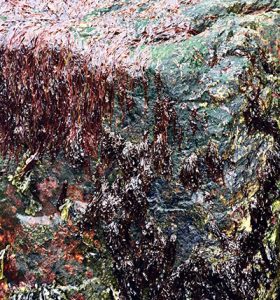Dr. Senjie Lin and his current and former Ph. D. graduate students, Brittany Sprecher and Yunyun Zhuang, engaged in an international collaboration to sequence Porphyra umbilicalis’ nuclear genome. Their efforts revealed how the red algae has been able to thrive in the harsh intertidal zone under exposure to high UV radiation, changing temperatures, and severe osmotic stress and desiccation for more than a billion years. Porphyra umbilicalis belongs to an ancient group of red algae, Bangiophyceae, and is a valuable human food source.
The team’s analysis found that P. umbilicalis has a small set of cytoskeleton motor proteins (explaining why red algae are smaller in size when compared to most multicellular lineages), several cellular mechanisms to cope with the stressful environment, and a high capacity for nutrient uptake and utilization.
Major support for the genome sequencing was through a contract with the U.S. Department of Energy’s Joint Genome Institute, sequencing analysis was supported by a National Science Foundations Research Collaboration Network grant, and the project was led by Dr. Susan Brawley at the University of Maine. The findings are published by Proceedings of the National Academy of Sciences.
